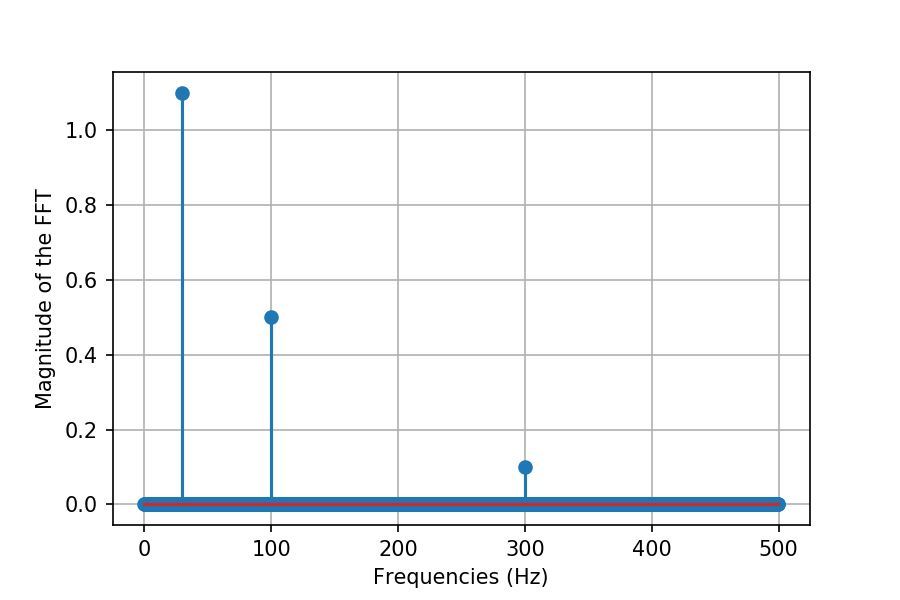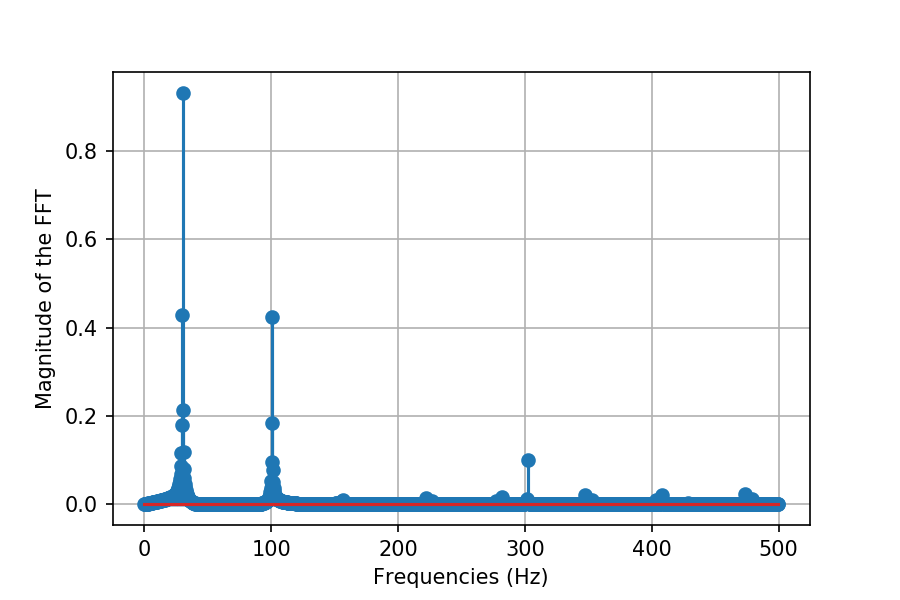I'm trying to implement direct implementation of MDCT filter bank. So, some additional artefacts have appeared after all of the routines.
The spectrum of the initial signal looks like:

import numpy as np
import matplotlib.pyplot as plt
N = 8 #subbands
L = 2*N
h = np.zeros((L,1)) #skeleton for window function
for n in range(2*N-1):
h[n] = np.sin((np.pi / (2 * N)) * (n + 0.5)) #window function
w = [30, 100, 300]
a = [1.1, .5, .1]
x = 0
t = np.array([i for i in range(1,3001)])/1000
for idx in range(len(w)):
x = x + a[idx]*np.sin(2*np.pi*w[idx]*t)
FFT = np.fft.fft(x)
amps = np.abs(FFT) / (len(FFT) / 2)
fs = 1 / (t[1]-t[0])
f = fs*np.array([i for i in range(int(len(x)))]) / len(x)
plt.subplots(1, 1, figsize=(6, 4), dpi=150)
plt.stem(f[:int(len(f)/2)], amps[:int(len(f)/2)])
plt.ylabel('Magnitude of the FFT')
plt.xlabel('Frequencies (Hz)')
plt.grid(True)
plt.show()
# Analysis
H = np.zeros((N,L)) #skeleton for analisis H matrix
pr = (L+len(x)-1) #lengh (number of coloumn) of signal after convolution
Analysis_Mat = np.zeros((N,pr)) #skeleton for matrix after convolution
for k in range(N): #rows
for n in range(L): #coloumns
H[k,n] = h[n]*np.cos((np.pi/N)*(k+0.5)*(n+0.5-(N/2))) #analysis H matrix
Analysis_Mat[k,:] = np.convolve(x,H[k,:]) #convolution
# Downsampling
M = int(Analysis_Mat.shape[1] / N) #number of samles that sould be stay after downsampling
cutmat = int(np.floor(M)*N) #number of rows that sould follow to downsampln block (cut rows that are not fold to N)
Analysis_Mat_DS = np.zeros((N, M))
Analysis_Mat = Analysis_Mat[:, :cutmat]
for k in range(N):
Analysis_Mat_DS[k, :] = Analysis_Mat[k,::N]
# Upsampling
Analysis_Mat_US = np.zeros((N, Analysis_Mat_DS.shape[1]*N)) #skeleton for signal that should be after upsampling
for n in range(Analysis_Mat_DS.shape[1]):
Analysis_Mat_US[:,0+N*n] = Analysis_Mat_DS[:, n]
# Synthesis
R = L + Analysis_Mat_US.shape[1] - 1 #legth of signal (number o rows) that should be after convolution
Syntesis_Mat = np.zeros((N,R)) #skeleton for signal that should be after convolution
G = (np.fliplr(H))/(N/2) #Synthesis matrix
for k in range(N):
Syntesis_Mat[k,:] = np.convolve(Analysis_Mat_US[k,:], G[k,:]) #convolution
y = np.sum(Syntesis_Mat, axis=0)
FFT = np.fft.fft(y)
amps = np.abs(FFT) / (len(FFT) / 2)
fs = 1 / (t[1]-t[0])
f = fs*np.array([i for i in range(int(len(x)))]) / len(x)
plt.subplots(1, 1, figsize=(6, 4), dpi=150)
plt.stem(f[:int(len(f)/2)], amps[:int(len(f)/2)])
plt.ylabel('Magnitude of the FFT')
plt.xlabel('Frequencies (Hz)')
plt.grid(True)
plt.show()
However, the reconstructed spectrum looks like:

Is it OK? Is there a mistake in my script or I don't understand the theory (or both)?
Can anybody help me with this issue?
